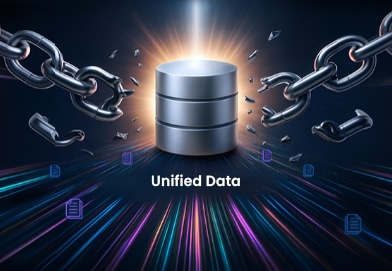Businesses are constantly seeking ways to leverage the power of data to gain a competitive edge. One essential aspect of this pursuit is the ability to store, transfer, and process data efficiently, securely, and accurately.
Enter the realm of database migration tools! These robust software solutions are designed to help businesses transform and move data between database systems while ensuring the integrity and accuracy of the information. But with countless options available, how do companies choose the right tool for their needs?
This blog post will explore the top 10 database migration tools, their features, and the key factors to consider when selecting the perfect tool for your business.
Database Migration Tools Key Takeaways
Database Migration Tools allow businesses to transfer data between databases safely and accurately.
When selecting a database migration tool for your business, consider its features, pricing reviews, security & compliance standards, customization options & other factors.
Benefits of using Database Migration Tools include improved operations, increased security & enhanced decision-making capabilities, resulting in improved performance
Overview of Database Migration Tools

Modern businesses rely heavily on data management and database migration tools. They simplify the data migration process and assist in transferring data from one data source to another. These tools are employed in various scenarios, such as new hardware configuration, migrating to a new database engine, decommissioning old hardware, or moving workloads to the cloud.
Data migration can occur locally or remotely, involving data transfer between locations on the same computer or over a network or the internet from one computer to another. Various data movement tools exist to accommodate the diversity of data migration needs, ranging from on-premises solutions like Informatica PowerCenter, Oracle Data Service Integrator, and IBM Infosphere to cloud-based options such as AWS Database Migration Service and Fivetran.
Purpose of Database Migration Tools
Database migration tools primarily aim to:
Ease the transfer of data between various databases
Minimize the need for manual data recreation or manipulation
Ensure data integrity and accuracy
Programmatically transfer data with the help of specific tools
Establish links between the source and targets using required protocols, APIs, or drivers.
Businesses that employ database migration tools enjoy several advantages, including cost savings, improved competitiveness and performance, and efficient data extraction and loading.
However, data migration projects can come with challenges and risks, such as potential data inaccuracies in the target location and the need to adhere to various regulatory and privacy standards like SOC 2, HIPAA, ISO, GDPR, CCPA, etc.
Types of Database Migration Tools
There are three main categories of database migration tools: On-Premises, Cloud-Based, and Self-Scripted. These tools are designed to deal with both structured and unstructured data.
They can communicate with databases, enterprise applications, data warehouses, and many different file formats, including spreadsheets, JSON, XML, CSV, and more..
Data transformation capabilities are crucial in these tools, as they must detect and rectify discrepancies or problems and transform data types to meet the target data type requirements. Cloud-based data migration tools are particularly advantageous, as they enable data transition from on-premises to cloud systems, provide high security, and are cost-efficient.
FOR INSTANCE, the AWS Database Migration Service is a popular tool that facilitates data transfer to and from widely used commercial and open-source databases.
Best Database Migration Tools

This part of the article uncovers the top data migration tools, emphasizing their unique features and benefits. These best data migration tools on the market include AWS Database Migration Service, IBM Informix, Matillion, Fivetran, Stitch, Hevo Data, Integrate.io, Dell EMC, and IRI NextForm.
A structured research methodology was employed to analyze these tools based on predefined evaluation criteria and essential feature requirements.
The top tools offer plug-ins or modules, scalability, auto-detection of missing items, connector modules, automated workflows, data migration testing processes, comprehensive connector coverage, high availability data replication, and interoperability with legacy systems.
AWS Database Migration Service
The AWS Database Migration Service offers the following benefits and features for cloud migration:
High-performance tool
Support for transferring databases to AWS
Minimal downtime during the migration process
Smooth and secure migration process
The AWS Database Migration Service can transfer data to and from the most commonly used commercial and open-source databases, making it a versatile choice for businesses transitioning to a modern data platform.
IBM Informix
IBM Informix is a data migration solution that utilizes SQL commands to further facilitate data migration and transfer between IBM Informix databases and operating systems. The intuitive GUI offered by this software makes workflows more streamlined. Users can migrate data between various databases and platforms easily.
IBM Informix operates on a hybrid Cloud infrastructure, which assists enterprises in minimizing hardware and software maintenance costs and enhances data migration.
Matillion
Matillion is a cloud-based Extract, Transform, and Load (ETL) solution for data migration between different systems, databases, and platforms. Built-in analytics features and the ability to load, transform, sync, and orchestrate data all in one place make Matillion a convenient and efficient option for businesses looking to optimize their data operations.
Fivetran
Fivetran is a cloud-based Extract, Load, and Transform (ELT) data migration tool that offers the following features:
14-day free trial
Utilizes a consumption-based pricing model
Provides pre-built connectors for multiple data sources
Facilitates data migration by managing all data integration tasks automatically
Works with DBT data build tool.
These features make Fivetran an ideal choice for businesses seeking to centralize and streamline their data operations.
Stitch
Stitch is an enterprise-grade cloud Extract, Transform, and Load (ETL) platform that offers:
Fully automated cloud data pipelines without requiring coding expertise
Consolidation of data from a wide array of sources
Extraction of valuable insights
Stitch’s transparent and predictable pricing model, with no hidden fees, makes it an appealing option for businesses looking to optimize their data migration efforts. They recently bought Talend.
Hevo Data
Hevo Data is a cloud-based data integration platform that allows businesses to replicate data from multiple sources to a data warehouse. Offering support for over 150 sources, Hevo Data is a powerful database migration tool that can be compared to other most popular data migration tools like AWS Database Migration Service and IBM Informix.
With three pricing tiers available, Hevo Data is a cost-effective solution for businesses looking to migrate their data.
Integrate.io

Integrate.io is a popular data migration tool that provides a unified interface for managing, transforming, and transferring data between multiple applications. With over 140 cloud data sources, Data Warehouses, and Databases, Integrate.io offers a drag-and-drop no-code interface to access various SaaS apps and services.
Pricing is based on the number of connectors utilized, making it a cost-effective option for businesses with varying data migration requirements.
Dell EMC
Dell EMC is a data migration solution that centers around three core pillars: discovery, planning, and execution. Its Intelligent Data Mobility methodology enables businesses to optimize their data migration efforts and achieve successful outcomes.
Though explicit pricing information is unavailable, Dell EMC’s data migration services can provide businesses with the tools and expertise needed for a successful data center migration project.
IRI NextForm

IRI NextForm is a data migration, reformatting, conversion, replication, federation, and reporting solution that enables data to be transferred from one system or format to another and from legacy systems into new environments. It combines the high-volume data transformation capabilities of CoSort with the user-friendly interface of Eclipse, providing users with a comprehensive data migration tool.
With various pricing options available for its products, IRI NextForm offers a flexible solution for businesses needing efficient and effective data migration.
Key Features to Consider When Choosing a Database Migration Tool
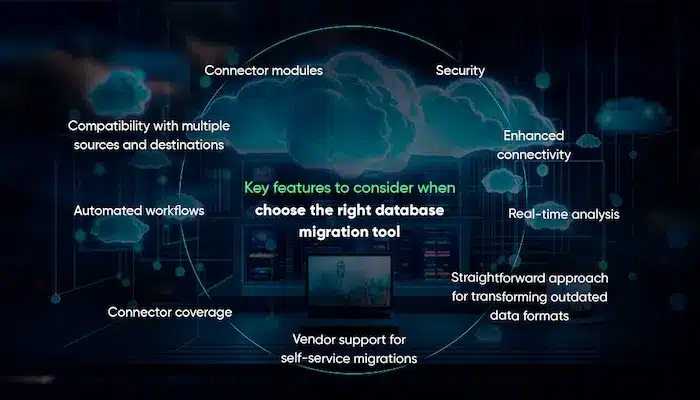
When choosing a database migration tool for your business, key features like scalability, reliability, and versatility should not be overlooked. Here are some critical factors to take into account:
Compatibility with multiple sources and destinations
Connector modules
Security
Enhanced connectivity
Automated workflows
Connector coverage
Real-time analysis
Vendor support for self-service migrations
Straightforward approach for transforming outdated data formats
By focusing on these essential features, businesses can ensure that they choose the best data migration tool to meet their specific needs and requirements.
Furthermore, during the evaluation of data migration tools, it’s vital to take into account factors like:
File format compatibility
Bandwidth constraints
The tool’s pricing structure, which could be influenced by the number of users and the preference for an online or offline solution
By carefully weighing these factors, businesses can make an informed decision and select the right data migration tool to achieve a successful migration project, including the ability to load data efficiently.
How to Choose the Right Database Migration Tool for Your Business
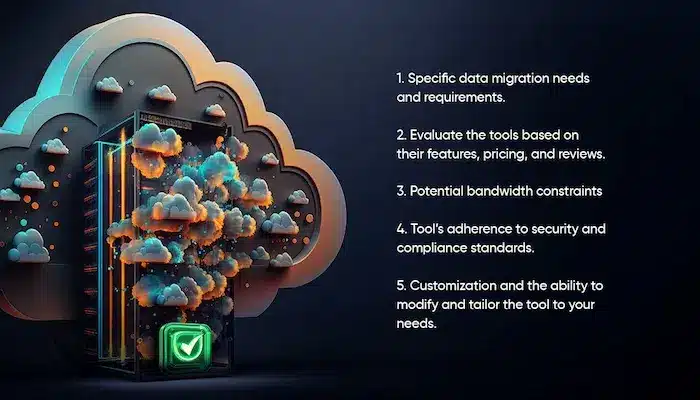
The first step in choosing the right database migration tool for your business is identifying your specific data migration needs and requirements. Consider the types of data to be migrated, the systems and platforms involved, and any compatibility issues that may arise during the migration process.
Evaluating the available tools based on their features, pricing, and reviews is crucial to ensure that the chosen tool aligns with your business objectives and infrastructure. Additionally, make sure to take into account any potential bandwidth constraints, as well as the tool’s adherence to security and compliance standards.
Finally, don’t underestimate the importance of customization and the ability to modify and tailor the tool to your needs. By carefully evaluating each aspect and selecting the right data migration tool, businesses can ensure a smooth and successful migration project that optimizes their data operations and enhances their competitive edge.
Benefits of Using Database Migration Tools
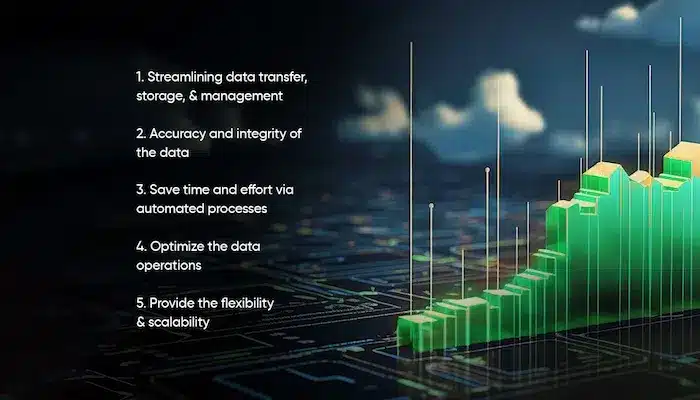
The use of database migration tools brings about a myriad of benefits for businesses. Some of these benefits include:
Streamlining data transfer, storage, and management operations
Allowing companies to focus on other core activities while ensuring the accuracy and integrity of their data
Saving time and effort through automated processes
Enabling businesses to optimize their data operations with ease
Additionally, database migration tools provide the flexibility and scalability to meet specific requirements, making them a valuable asset for businesses of all sizes and industries. Moreover, database migration tools enhance data security and compliance, as they adhere to strict security and compliance standards such as:
SOC 2
HIPAA
ISO
GDPR
CCPA
By leveraging these tools, businesses can protect their sensitive data and avoid legal ramifications.
Overall, using database migration tools empowers businesses to make better, data-driven decisions, ultimately leading to improved performance and competitiveness in the market.
Challenges and Risks in Data Migration

Even though database migration tools bring numerous benefits, potential challenges and risks come hand in hand with a good data migration tool. Data loss, system downtime, and compatibility issues are just a few potential pitfalls businesses may encounter during the migration process. To mitigate these risks, it is essential to thoroughly assess the chosen tool’s capabilities and ensure it aligns with the specific needs and requirements of the business.
Another essential aspect to consider is the tool’s adherence to regulatory and privacy standards, such as:
SOC 2
HIPAA
ISO
GDPR
CCPA
Maintaining compliance with these standards ensures the protection of sensitive data and helps businesses avoid potential legal issues. By carefully evaluating and selecting the right data migration tool, businesses can successfully navigate the challenges and risks associated with data migration and achieve a secure and efficient, successful data migration’ project.
Open-Source vs. Licensed Database Migration Tools
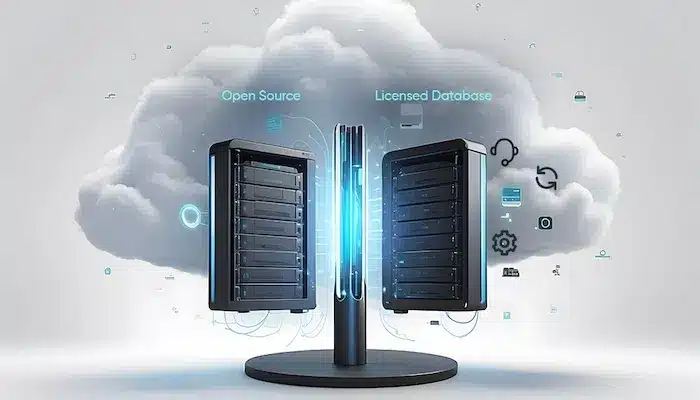
In the process of selecting a database migration tool, it’s also necessary for businesses to weigh up whether an open-source or licensed tool is more suitable for their needs. Open-source tools are freely available and allow users to modify and customize the code, potentially providing greater flexibility and control. However, these tools may lack the specialized support and maintenance provided by licensed tools developed and maintained by a dedicated team.
Licensed tools, on the other hand, are purchased from a vendor and typically come with robust support, updates, and maintenance. While these tools may offer a more polished and reliable experience, they can also come with a higher price tag. Ultimately, the choice between open-source and licensed database migration tools will depend on budget, customization requirements, and the level of support needed.
By carefully considering these factors, businesses can select the appropriate tool for their data migration needs and enjoy a successful migration project.
Case Studies: Successful Database Migration Projects
Examining successful database migration projects can be valuable insights and inspiration for businesses about to embark on their migration journey. For example, some successful migrations include:
IBM Informix’s transfers from SQL Server to Informix, Informix to Aurora PostgreSQL, and Informix to MySQL
Marillion’s facilitation of DocuSign’s transition to Snowflake and integration with Matillion ETL
Matillion facilitated Musti Group’s business logic rebuild, Snowflake migration, and production launch within just five months.
Similarly, Fivetran has achieved numerous successful database migrations, including transitioning Copyright, a nonprofit agency, to a cloud data warehouse using Fivetran and Snowflake.
These case studies demonstrate the potential for successful database migration projects using the right tools, strategies, and support.
By learning from these examples and carefully selecting the appropriate database migration tool, businesses can achieve successful migration projects and fully harness the power of their data.
Summary
In conclusion, database migration tools are crucial in helping businesses optimize their data operations and enhance their competitive edge. By selecting the right tool, companies can ensure efficient, secure, and accurate data transfer between various systems and platforms while maintaining compliance with regulatory and privacy standards. The top 10 database migration tools, including AWS Database Migration Service, IBM Informix, Matillion, Fivetran, Stitch, Hevo Data, Integrate.io, Azure DocumentDB, Dell EMC, and IRI NextForm, offer robust features and capabilities to address a wide range of data migration needs.
When choosing the best database migration tool for your business, it’s essential to consider factors such as scalability, reliability, versatility, compatibility with multiple sources and destinations, and adherence to security and compliance standards. By carefully evaluating these aspects and learning from successful migration case studies, businesses can embark on their successful migration journey and fully leverage the power of their data to drive growth and success.
Frequently Asked Questions
What are database migration tools?
Database migration tools are software used to efficiently move data between different data sources, aiding in transitioning from an outdated system to a new one and managing and securing data.
Which tool is best for data migration?
The best tool for data migration depends on the migration’s complexity and the project’s scope. However, five of the most recommended tools are Fivetran, Talend Open Studio, Matillion, Integrate.io, and Informatica. Each tool offers different levels and types of data migration features and automation to help simplify data migration tasks.
What are the three migration strategies for databases?
Database migrations can be done using Big Bang, Trickle or Zero-Downtime strategies. Big Bang is a single transfer operation at one point in time. Trickle involves gradually transferring data from one source to the target database, and zero downtime ensures no interruption in service during the migration.
What is the tool to migrate SQL Server?
The Microsoft Data Migration Assistant (DMA) and the Microsoft SQL Server Management Studio (SSMS) are viable tools for migrating to SQL Server. Additionally, you can use the SQL Server Migration Assistant (SSMA) to automate database migration from alternative database engines, such as Microsoft Access, DB2, MySQL, Oracle, and SAP ASE.
What is the main purpose of database migration tools?
Database migration tools provide a simple, efficient way to move data between locations, formats, and applications with minimal effort.


